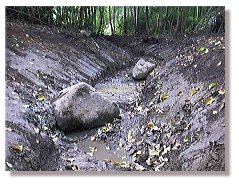Boulders and Stream
Complexing
By Damien Barstead
Stream complexing is a term used to describe the factors that create the many habitat
areas within a stream channel. There are many factors that contribute to the complexity of a
stream. Two examples are the positioning of large woody debris, and the placement of boulders
in a stream. Both of these components will potentially alter the flow patterns of a stream by
creating riffles, back eddies, pools, large rapids, or glides. Substantial shade and cover for fish
will also be available under these boulders and logs. All of the factors which contribute to the
complexity of a stream, and alter stream characteristics, are very important parst of salmon and
trout habitat.
Although much woody debris and a few boulders may naturally work their way into
the stream channel over time, the Haig-Brown Kingfisher Creek Restoration Project is helping
the process by adding these features before water even enters the new creek.
Because boulders are less likely to wash into a system due to their size and weight, it
is important to manually place them so that they will continuously add useful habitat.
|

Placing boulders and little pools will
add fish shelter
and complexity to the
new stream channel.
For example, in the above picture, several boulders are placed in a straight section of
the creek, with miniature pools immediately after the boulders. What this combination
accomplishes is the creation of calm waters on the downstream side of the boulder, creating nice
places for young salmon to hang out. The pools will allow them to swim deeper, thus reducing
their visibility to predators.
There will be many boulders placed throughout the new creek channel. As well,
efforts will continually be made to add complexity to areas of the creek where either the water
flows too fast and may cause erosion, or where there is a lack of existing habitat.
Historically, it was thought that streams littered with wood and rock were messy and
had to be cleaned up. Granted, in very extreme cases this is true, but for the most part, boulders
and woody debris are some of the best types of habitat available, and we must ensure that there
is an ample supply of both in all of our streams.
Top of page.
|

